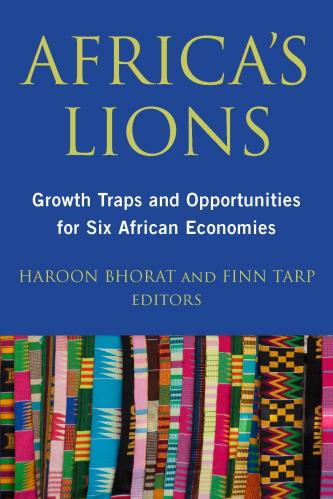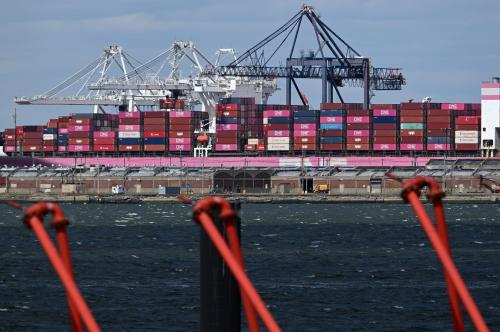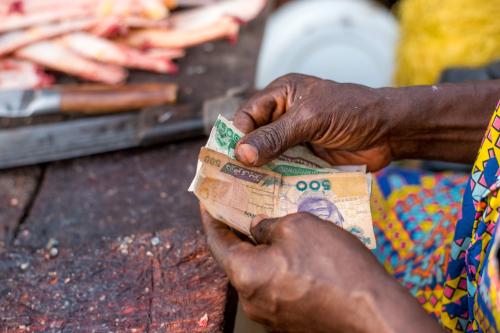This week, AGI Nonresident Senior Fellow and Director of the Development Policy Research Center at the University of Cape Town Haroon Bhorat and Director of the United Nations University-World Institute for Development Economics Research Finn Tarp launch their newest book, Africa’s Lions, examining the key factors influencing economic growth and development in Kenya, Nigeria, Ghana, Ethiopia, Mozambique, and South Africa.
Bhorat and Tarp, the book’s editors, bring together a collection of analyses including demographic shifts, labor market trends, structural transformation, and others. The chapter authors harness country-level data on economic indicators to provide recommendations for policymakers to make informed policy decisions. This week, we take a look at the brief detailing Kenya’s unique set of development challenges and opportunities as highlighted in the book.
Kenya’s economy, powered by its booming financial services and information and communication technologies sectors, has grown over the past decade at an average of 4.37 percent. While encouraging, the growth has not radically transformed the country: The majority of the population still lives in poor, rural areas with low health, governance, and education indicators. Nevertheless, the book notes that there are two primary reasons for optimism: Kenya’s rapidly growing youth population, if managed carefully, can accelerate economic growth while its strong middle class and large growing urban population present an opportunity for domestic demand driven growth.
Kenya is in the midst of a demographic dividend: A situation where the working-age population is substantially larger than the dependent (young or retired) population due to declining birth and mortality rates. Since 1993, the working-age population has been larger than the dependent population. More encouragingly, the largest demographic cohort is the 0-14 bracket; the authors hope that the entrance of this cohort into the workforce will drive growth, innovation, and investment.
Figure 1: Trends in Kenya’s working-age and dependent population, 1950 – 2050

However, as the authors emphasize, the dividend must be managed properly for it to spur and sustain growth. First, the government must ensure that the youth have the technical skills to productively join the job market by investing in education. Second, in order to pave the way for sustained growth, the government must develop efficient bureaucracies and high-quality institutions that respect the rule of law and freedom of speech, have low levels of corruption, and promote good infrastructure. While the devolution in Kenya’s 2010 constitution was a good first step, they say, further reforms are necessary to achieve sustainable growth.
With 44.9 percent of the population earning between $2 and $20 a day, Kenya has East Africa’s largest middle class proportionally. The emergence of a strong middle class catalyzes both social changes—such as institutional reform—and economic growth, through increased domestic and foreign investment, high retail, and housing sector growth, and a developing entrepreneurship ecosystem.
Finally, according to the authors, Kenya’s rapidly urbanizing economy provides opportunities for infrastructure development across its urban centers. Nairobi is set to become a 10-million-person “megacity” in a couple of decades. Kenya’s urban population will increase 7 percent in less than a decade, from 25.5 percent in 2014 to approximately 33 percent in 2030. The large city population growth will drive productivity gains and further contribute to economic growth in the medium term.
Again, while the economic growth potential is present, the authors stress that the government must institute policies to create the right kinds of jobs for the growing, urban middle class. Unfortunately, the majority of jobs created in the past decades have been in the informal sector. An overreliance on informal sector growth raises sustainability questions in the medium to long term: Informal businesses struggle to expand, are less productive, and pay lower wages than formal counterparts.
Table 1: Trends in Kenya’s formal/modern sector and informal sector employment, 1985 – 2014

Because of its strong fundamentals, Kenya is primed for robust economic growth. To capitalize on the demographic dividend and create formal jobs for the new middle class, the authors recommend the following to policymakers:
- To capitalize on the demographic dividend
- Support the building of quality institutions
- Improve service delivery through better infrastructure such as health, schools and transport
- Provide for the formal labor market with unions and laws protecting both employees and employers
- To create formal jobs for the new middle class:
- Encourage rapid growth in capital accumulation
- Boost private sector investment
- Identify obstacles to and create policies for enhancing labor mobility between the informal and formal sectors.
Kenya is just one of six countries profiled in Africa’s Lions. Kenya, as well as Mozambique, South Africa, Ghana, Nigeria, and Ethiopia, will largely shape the continent’s future. Each country chapter focuses on the complex interactions between economic growth and employment outcomes, within the individual Africa’s Lions context. To attend the Africa’s Lions launch event from 5:45-7:00pm on Thursday, November 3 at Brookings, please register here.
Note: The African Lions project is a collaboration among United Nations University-World Institute for Development Economics Research (UNU-WIDER), the University of Cape Town’s Development Policy Research Unit (DPRU), and the Brookings Africa Growth Initiative, that provides an analytical basis for policy recommendations and value-added guidance to domestic policymakers in the fast-growing economies of Africa, as well as for the broader global community interested in the development of the region. The six papers, covering Mozambique, Nigeria, Kenya, Ghana, South Africa, and Ethiopia explore the key constraints facing African economies as they attempt to maintain a long-run economic growth and development trajectory.
Junaid Belo-Osagie contributed to this post.
The Brookings Institution is committed to quality, independence, and impact.
We are supported by a diverse array of funders. In line with our values and policies, each Brookings publication represents the sole views of its author(s).





Commentary
Figures of the week: Kenya’s growth trends and prospects in Africa’s Lions
November 2, 2016